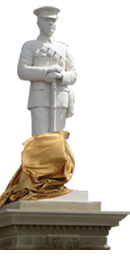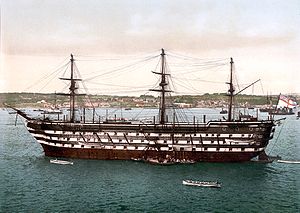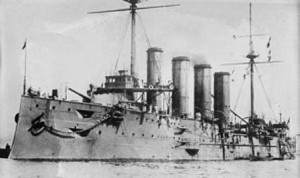Able Seaman Ernest Sidney Alston
197019 Royal Navy
Ernest Alston was born on 10th April 1882 in Braintree, Essex son of John and Jane Alston of Colchester, Essex. He joined the Royal Navy as a Boy Seaman in December 1897 training aboard the three decker school ship HMS Impregnable. Impregnable was formerly HMS Howe and was never completed for sea service as her design was made obsolete by the introduction of ironclad ships.
Photo: HMS Howe, later school ship HMS Impregnable in the Hamoaze, Devonport Dockyard in the 1890s. Courtesy Wikipedia Photochrom Public Domain
In April to May 1899 he spent one month training aboard HMS Agincourt a Minotaur-class armoured frigate. On 31st May 1899 he was transferred to HMS Empress of India a Royal Sovereign-class, heavy armoured battleship, one of the largest and fastest ships of her time until the Dreadnought class was introduced. On his 18th birthday, whilst serving on the Agincourt, Ernest attained the rank of Ordinary Seaman. He remained on the Agincourt until 23rd Dec 1900. Ernest’s actual naval service counted from his 18th birthday on 10th April 1900, when he enlisted for 12 years service which would have comprised 7 years plus 5 years in the reserves. His naval record notes that at age 18, he stood 5’2″ tall with light brown hair, brown eyes and a fair complexion.
After six weeks at shore base Pembroke, Ernest was posted to sloop, HMS Hearty where he is recorded on the 1901 census because Hearty was stationed in the North Sea Fisheries and harboured at Lowestoft. In 1902 he married Christine Baker, a local Lowestoft girl in the Mutford Registration District. He served aboard Hearty until February 1903, followed by a 9 month tour of duty aboard steam yacht HMS Wildfire. From June 1904 to June 1905 he was stationed at HMS Tamar, the Royal Naval shore base in Hong Kong. HMS Vengeance had been undergoing a re-fit at Hong Kong and in 1905 when the British and Japanese agreed a treaty of alliance, there was a reduced need for battleships in the area, so in the June of that year, Vengeance was recalled and as Ernest’s naval period of engagement was coming to an end in a few months time, he sailed back aboard Vengeance via Singapore in a company of 4 battleships, Vengeance, sister ships Albion, Ocean and Centurion, arriving at Devonport, Plymouth in early August 1905. Ernest then saw a few months’ service at shore base Pembroke and on 20th January 1906 was transferred to the Royal Fleet Reserve, Chatham (to serve in the reserves until his 30th birthday on 10th April 1912.)
In 1911 Ernest was living at Main Road, Jacksdale with his wife Christine (nee Baker), employed as a canal labourer for the Midland Railway. A sixty nine year old widower from Huntingdon, named John Butterworth was living with them and working from their home as a halter maker. Ernest and Christine had been married for eight years and there had been only one child so far, who had not survived. Their daughter Alice May Alston born 1903 had died in 1910. Her birth and death are registered in the Mansfield Registration District, indicating they obviously lived in the Mansfield area for a period of time.
On 25th March 1912, a few weeks before his time in the reserve was up, Ernest re-enrolled for service until his 35th birthday - 10th April 1917, but does not appear to have served actively until 13th July 1914 when he was aboard HMS Leviathan, a Drake-class armoured cruiser until 25th August 1916. On 18th July 1914 she was at Portsmouth and fired a 21 gun salute on the arrival of HM King George V and on the following day King George passed through the line in HM Yacht, Victoria and Albert.
HMS Leviathan courtesy of Wikipedia (Public Domain)
Leviathan had joined the 6th Cruiser Squadron on the outbreak of WW1. The ship’s log notes that on 1st August 1914 they were preparing the ship for war and had also sighted Land’s End. On the 5th August the log notes that they had received information via wireless telegraph that Great Britain had declared war on Germany. Leviathan patrolled to Fayal, Portugal, the Ascension Isles, Gibraltar, then back to Milford Haven and to Cromarty, Scotland and to Scapa Flow. She then proceeded onwards to Bermuda, Chesapeake Bay (Virginia) and Halifax (Nova Scotia) before returning to Jamaica, then Halifax and back to Jamaica and Barbados. On the 3rd Feb 1916 the log noted that the ship’s company observed an eclipse of the sun. Ernest certainly travelled the high seas on Leviathan, a cruiser that survived WW1 and was eventually sold in 1920. Ernest spent a month at shore base Victory and then six months aboard HMS Crescent, a first class cruiser of the Edgar class which also survived WW1. Ernest was discharged from the Royal Navy on 11th September 1917 and paid a war gratuity. There is a note on his service record which indicates he may have suffered some kind of curvature of the spine. His entry in the UK Naval Medal and Awards Rolls indicates that he was awarded the 12914-15 Star and the British War and Victory Medals as well as Silver War Badge number 16440.
Ernest was a shopkeeper during and after the war and had premises situated directly opposite the Jacksdale Miners Institute (Now the Dale Club) on Main Road Jacksdale. He later moved premises to 22, Main Road. (Information supplied by Ken Haddon, long standing resident of Jacksdale..) This information is also confirmed by insertions in Kelly’s Directory for the years 1916 and 1922.
Ernest died in 1955 in Colchester, Essex.











